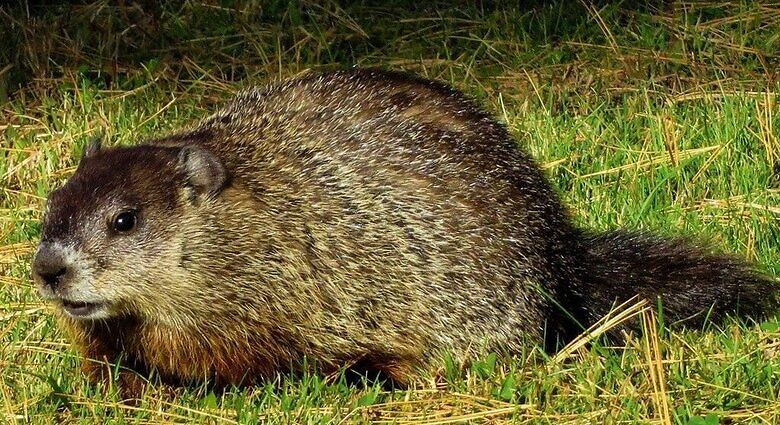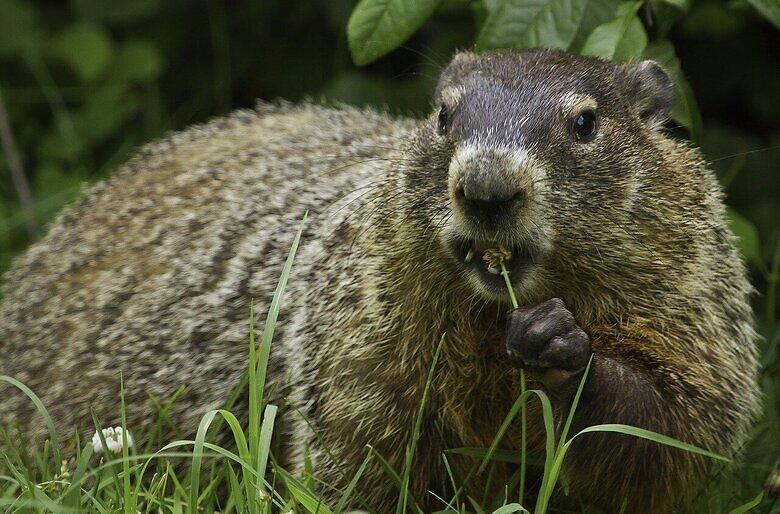About Nuisance Groundhogs

Biology
Body
The groundhog, commonly called woodchuck or whistle pig, is a large rodent of the family Sciuridae. Groundhogs have four incisor teeth, which grow around 1.6 mm per week. Adult groundhogs range anywhere from 15 to 24 inches in length and weigh anywhere between 5 and 13 pounds.
Feeding
Groundhogs are primarily active during the day, usually feeding early in the morning. They are herbivores and eat a variety of vegetables, including soybeans, peas, carrot tops, fruits, and grasses. Human activity has increased food access and abundance, allowing the groundhog to thrive.
Habits & Habitat
The groundhog prefers the open country and the edges of woodland and is rarely far from its burrow entrance. Most people probably see the groundhog as a weather predictor; however, those forecasts are a mixed bag, only accurate a third of the time. Groundhogs are lonely creatures, spending their summers and falls overfeeding for winter hibernation. They eat over a pound of food per sitting.
Burrows
Groundhogs are excellent diggers; they can dig both simple and complex burrow systems. Most burrows are 24 to 32 feet long and from two to five feet deep, with two to a dozen entrances. The main entrance is often the most noticeable, with a large mound of freshly dug dirt nearby. The other, less visible entries are used for escaping from predators which include man, dogs, coyote, foxes, and hawks. Groundhogs rely on their keen sense of smell and hearing to detect danger.
Problems Groundhogs Cause
In summary, groundhogs may:
- Damage crops by feeding in farm fields and/or home gardens
- Burrow holes and dirt mounds which hamper the operation of farm equipment and can pose a threat to farm animals
- Damage fruit and decorative trees caused by gnawing for scent marking or sharpening their claws and teeth
- Cause rabies in humans, which can be fatal if left untreated
- Damage building foundations and farm ponds
- Dens of groundhogs provide homes for other wild animals, including skunks and red foxes
Groundhogs like to burrow in fields and farms, along fences and roadsides, and near building foundations or the roots of trees, leaving mounds of soil at the dig site. These animals frequently invade farms and gardens, eating or destroying vegetables and plants. Although groundhogs are slow runners, they scamper quickly to their dens when they sense danger.
Groundhogs are considered a nuisance as they also damage building foundations, create unwanted holes on lawns, and cause outages from gnawing on underground electrical wires.
Groundhogs hardly come in contact with people, so they pose no significant public health issue. Though, they are capable of carrying fleas, ticks, and rabies.
Groundhogs may sometimes den in crawlspaces, so it is essential to:
- Inspect your home for entry points, including but not limited to broken vent covers or holes dug in your foundation.
- Seal all crevices and cracks, and install a mesh cover over chimneys and other openings.
If you suspect groundhogs in your property, contact a licensed wildlife control professional to advise the best method to get rid of the groundhog. Groundhogs are one of the most common wild animals that invade homes. Proactive nuisance pest control is necessary, as groundhogs are common carriers of rabies, a disease that is potentially fatal if left untreated.

Prevention
The best way to prevent groundhogs from your homes and gardens is by removing access to food, water, and shelter, which is basically what all animals need to survive.
The National Pest Management Association (NPMA) offers tips to homeowners for preventing a pest infestation:
- Seal cracks and holes, in and around the home’s exterior to block entryways
- Repair broke or poorly fitted window screens and loose/missing shingles
- Ensure that locations, where pipes and wiring enter homes, are properly sealed
- Do not leave unsealed food lying around, as it could attract groundhogs
- Keeping your gardens clean and picking up dropped fruit on the ground
Helps in preventing groundhogs:
- Feed pets indoors
- Use fencing to cover gardens and plants
- Use landscaping plants that do not attract groundhogs
- Use chimney covers and soffit vents
- Fence in areas such as gardens and underneath decks
Professional Removal Tactics
The best method to handle a groundhog problem is via trapping and removal. If you simply try filling the burrows, they often will dig their way out. If you use an animal repellent, groundhogs will ignore it or simply dig elsewhere. You do not need a license to kill or trap a nuisance groundhog. While wildlife are protected under the law, protection is removed if the animal is damaging private property.
- If you think that the groundhogs are under your home or shed, investigate the structure to distinguish the passage focuses – you’ll have to seal these territories shut after the creatures are gone.
- On the off chance that the groundhogs are living under a shed, deck, or patio, you’ll have to introduce a steel avoidance obstruction around the edge to keep them out. Make certain to cover it a foot underground, with the base of the steel fence bending outward, away from the structure.
- In the event that you’ve introduced a boundary, leave one area open to design a snare or a single direction prohibition entryway to get the woodchuck out.
- When catching, utilize a huge solid steel confine trap, 12″x12″x32″ in size. Continuously set the snare in the shade, to forestall overheating. Ensure the snare is on a strong, level surface.
- Set a snare at a tunnel site, and bait with new vegetables like broccoli or peas or natural corn. Try not to utilize the old apple and nutty spread strategy.
- The best opportunity to trap is in late-winter when the groundhogs are eager and hungry and there is less food available.
- If a groundhog is eating your nursery or different plants, you should fence your plants. You can purchase great fencing materials at Home Depot or some other home improvement shop. Make certain to cover the border of the fence or stake it down.
- It may not be legitimate for you to trap and migrate groundhogs in your state, yet in the event that it is, and on the off chance that you can do it without anyone’s help, relocate them five miles from your property to prevent them from returning.
- Repellent items, for example, mothball, granules, or powders, have no shown adequacy in fending groundhogs off. Be that as it may, a forceful pooch may work.
- You can fill in any open tunnels, yet on the off chance that there is a creature present, it will re-open them once more. The best strategy is to fill them after the animal is gone.
more information
5 Tips on keeping groundhogs Away
Best Ways to Trap a GROUNDHOG
Do GROUNDHOG Repellents Work?
Killing a Nuisance GROUNDHOG
Different Ways to Get Rid of GROUNDHOGs
Getting a GROUNDHOG Out of Your Shed or Porch
